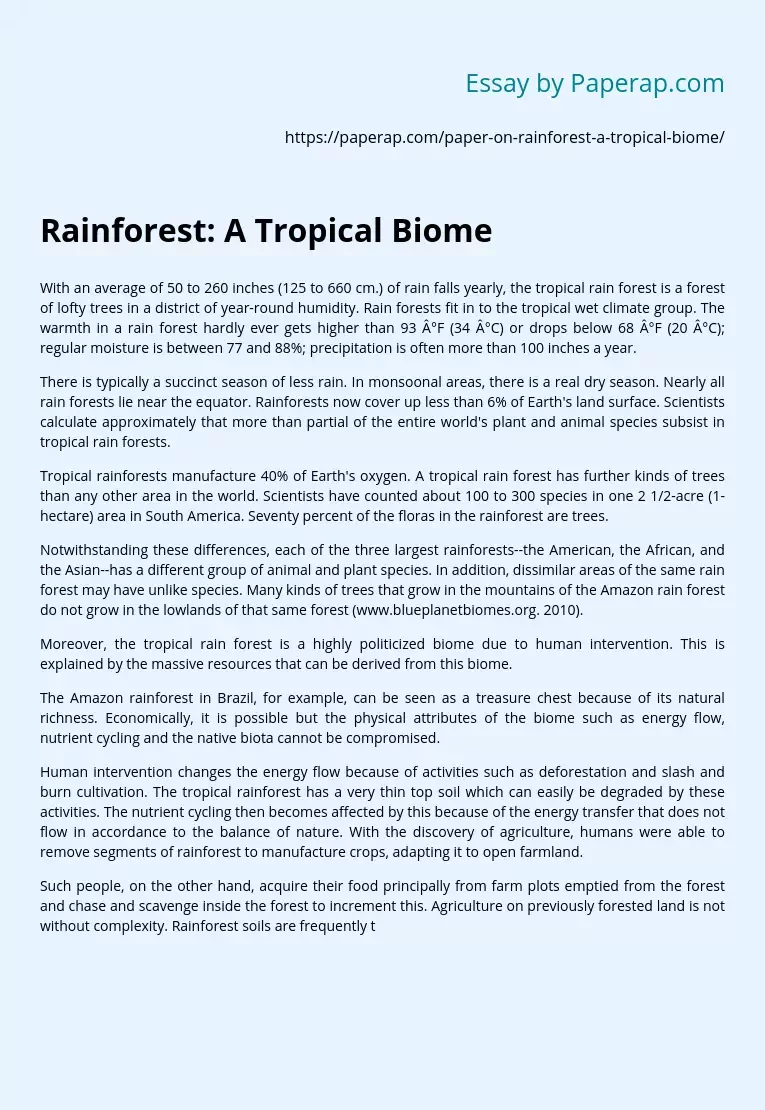Rainforest: A Tropical Biome
With an average of 50 to 260 inches (125 to 660 cm.) of rain falls yearly, the tropical rain forest is a forest of lofty trees in a district of year-round humidity. Rain forests fit in to the tropical wet climate group. The warmth in a rain forest hardly ever gets higher than 93 °F (34 °C) or drops below 68 °F (20 °C); regular moisture is between 77 and 88%; precipitation is often more than 100 inches a year.
There is typically a succinct season of less rain. In monsoonal areas, there is a real dry season.
Nearly all rain forests lie near the equator. Rainforests now cover up less than 6% of Earth’s land surface. Scientists calculate approximately that more than partial of the entire world’s plant and animal species subsist in tropical rain forests.
Tropical rainforests manufacture 40% of Earth’s oxygen. A tropical rain forest has further kinds of trees than any other area in the world. Scientists have counted about 100 to 300 species in one 2 1/2-acre (1-hectare) area in South America.
Seventy percent of the floras in the rainforest are trees.
Notwithstanding these differences, each of the three largest rainforests–the American, the African, and the Asian–has a different group of animal and plant species. In addition, dissimilar areas of the same rain forest may have unlike species. Many kinds of trees that grow in the mountains of the Amazon rain forest do not grow in the lowlands of that same forest (www.blueplanetbiomes.org. 2010).
Moreover, the tropical rain forest is a highly politicized biome due to human intervention.
This is explained by the massive resources that can be derived from this biome.
The Amazon rainforest in Brazil, for example, can be seen as a treasure chest because of its natural richness. Economically, it is possible but the physical attributes of the biome such as energy flow, nutrient cycling and the native biota cannot be compromised.
Human intervention changes the energy flow because of activities such as deforestation and slash and burn cultivation. The tropical rainforest has a very thin top soil which can easily be degraded by these activities. The nutrient cycling then becomes affected by this because of the energy transfer that does not flow in accordance to the balance of nature. With the discovery of agriculture, humans were able to remove segments of rainforest to manufacture crops, adapting it to open farmland.
Such people, on the other hand, acquire their food principally from farm plots emptied from the forest and chase and scavenge inside the forest to increment this. Agriculture on previously forested land is not without complexity. Rainforest soils are frequently thin and leached of numerous minerals, and the serious rainfall can quickly leach nutrients from area cleared for cultivation.
“People such as the Yanomamo of the Amazon, utilise slash-and-burn agriculture to overcome these limitations and enable them to push deep into what were previously rainforest environments. However, these are not rainforest dwellers; rather they are dwellers in cleared farmland that make forays into the rainforest. Up to 90% of the typical Yanamomo diet comes from farmed plants (Calderon, 2010).”
Air, water and land in tropical rainforests have been modified extensively to satisfy man’s needs. The areas were converted into watershed areas, parks and outdoor recreation areas and subdivisions for homes. These alter the most basic functions of the tropical biome which can eventually lead to its death and unproductivity.
BIBLIOGRAPHY
Calderon, M.M. (2006). General forestry syllabus. UPLB: College of Forestry and Natural
Resources.
Contreras, A.P. (2002). Locating the political in the ecological: Globalization, state-civil
society articulations, and environmental governance in the Philippines. Quezon City: De La Salle University Printing Press.
Dolom, B.L. (und.). The DENR’s social forestry programs: planning and implementation schemes. Unpublished manuscript.
Durst, P.B. (Ed.). (2006). Presentation to the expert consultation on establishing a regional
forest policy network. Manila: Traders Hotel. Enhancing participation in local governance experiences from the Philippines. (2001). Cavite,
Philippines: International Institure of Rural Reconstruction.
Gendrano, O.A. (2008). Oscar: A man of the forest (Memoirs of a forester). Quezon City: Central print on demand.
Marsh, D. & Stoker, G. (1999). Theory and methods in political science. College of Forestry and Natural Resources: Department of Social Forestry and Forest Governance reading room.
Mayers, J. & Bass, S. (2004). Policy that works for forests and people: Real prospects for governance and livelihoods. United Kingdom: Earthscan.
Pulhin, J.M. & Peras, R.J.J. (2009). [SFFG 125: Part 2. Lecture]. University of the Philippines Los Baños.
Santos, E.P. (und.). [SFFG 111 syllabus]. University of the Philippines Los Baños.
Todaro, M.P. (1989). Economic development in the third world. (4th ed.). New York: Pitman publishing Inc.
Rainforest: A Tropical Biome. (2018, Aug 13). Retrieved from https://paperap.com/paper-on-rainforest-a-tropical-biome/

